Dateline – Summer 2020 – Dallas, Texas
Some of you may remember from a few years ago a story I did about an encounter with a big black Dog running with a couple of wild Coyotes down in Dallas’ Great Trinity Forest. It was a stunning and unexpected sighting, to say the least.
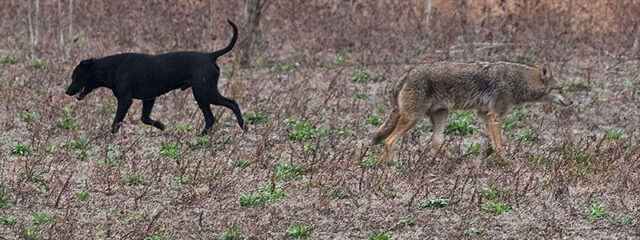
While the encounter lasted, I was able to make a few mental notes about the behaviors I witnessed. The Coyotes were very businesslike—they seemed to have a routine they were trying to stick to. The Dog, on the other hand, was much more open to options.
My friend and I were standing on a game trail and it soon became apparent that we were blocking the Coyote’s way. The Coyotes spent a little time trying to wait us out, but the Dog was not nearly as patient. At first the Dog ran toward us barking loudly, before cutting his bluff short and turning back. Next the Dog tried to coax the Coyotes further away from us by retreating further down the expansive glade.
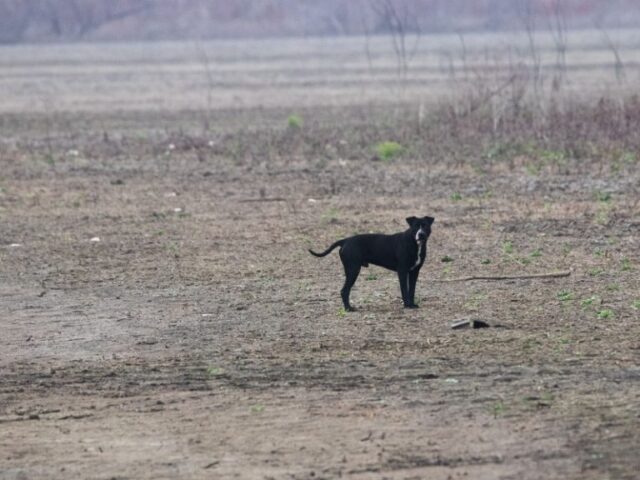
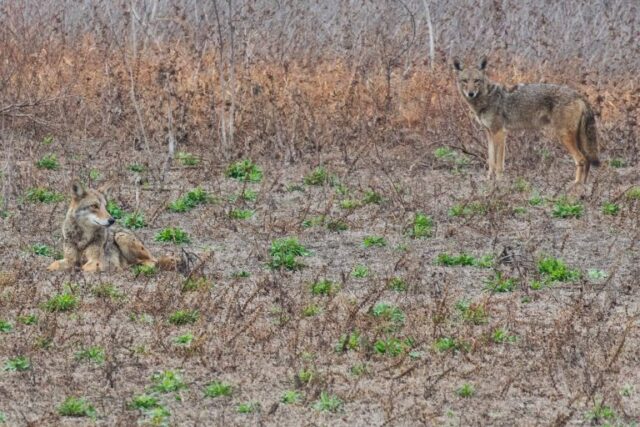
The Coyotes would have none of it. Instead, they stood their ground and hoped that we would move out of their way. After a time, when we did not leave, the Coyotes finally gave up and headed back into the brush, following the same path they had emerged from. The ever-enthusiastic Dog eagerly tagged along. And just like that the odd trio disappeared back into the forest.
As luck would have it, I had included a set of trail cameras in my pack that day. I decided that I would leave a few behind to see if they could give me a little more insight into the true dynamic between the two Coyotes and the wayward Dog.
When I retrieved the cameras a few weeks later, I found many pictures of Coyotes, but NO pictures of the big black Dog. At the time I concluded that the Dog-Coyote partnership must have been fleeting in nature. It appeared that the dog took up with the Coyotes simply because Dogs like to run with other Dogs—and Coyotes are kind of like Dogs.

The Coyotes seemed to tolerate the Dog as best they could, though the persistent mutt may not have given them much choice in the matter. It’s likely, that when the Dog had enough adventuring for one day he just wandered back home, and that was that.
I didn’t think much about it again until a few months ago when I noticed a comment on the blog stating that the poster had just witnessed a Dog running with Coyotes in the same general area. Now I was intrigued.
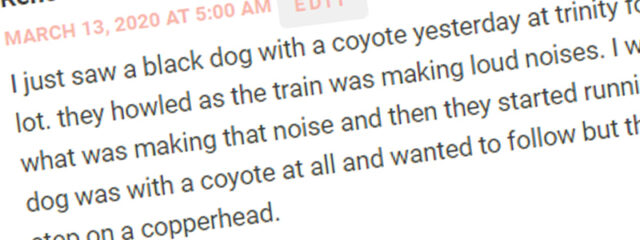
All north American candids are capable of interbreeding and producing fertile offspring—Wolves, Dogs, and Coyotes. Dogs (Canis lupus familiaris) and Coyotes (Canis latrans) will mate under certain conditions. The resulting hybrid pups are known as CoyDogs, and there is a real possibility that they can occur.

Read the full paper here…
This part of Dallas County is notorious for its stray Dog problem. The wilderness area here in the Great Trinity Forest is constrained and isolated. There is an abundance of Coyotes. If there were a place in Dallas County that would be conducive to the pairing of Dogs and Coyotes, this would be the place. I started to wonder if—just maybe—there were some CoyDogs in these woods waiting to be discovered. I decided to investigate by conducting a long term trail camera survey.
ARTICLE: D Magazine – Dallas Fights to Solve Stray Dog Problem
CoyDogs
CoyDogs that result from a male Dog mating with a female Coyote typically retain a Coyote’s general physiology—In other words, they present a Coyote’s silhouette. They will have a long, pointed snout, big, upright ears, long legs, and a bushy tail carried low.
Differences between CoyDogs and Coyotes can be subtle, and generally seem to express themselves as unique color morphs. Black, red, blonde, and piebald examples have all been documented.
Take for example this solid black Coyote recently photographed in the Austin area. Speculation is that this Coyote’s unusual coloration is due to the expression of genes acquired from hybridization with a Dog (though there are other possible explanations).
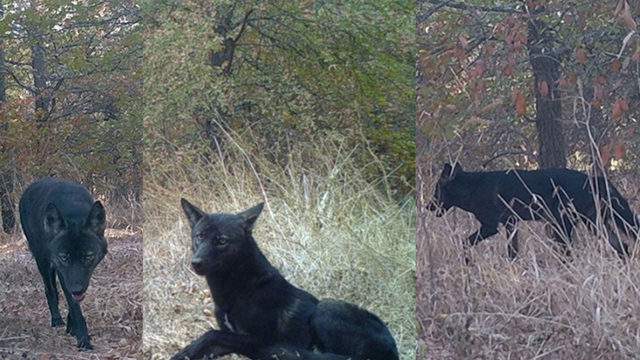
Click here to read more…
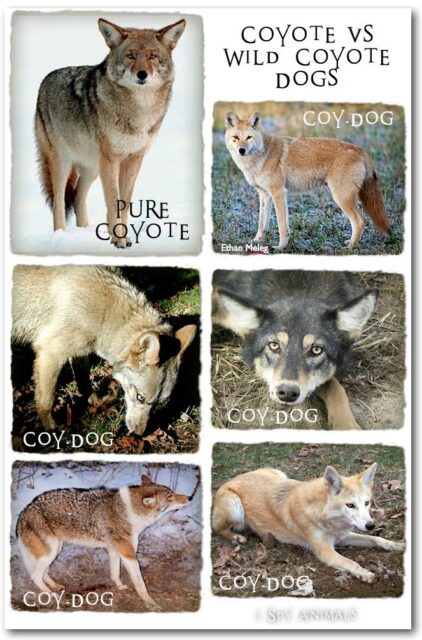
Picture from ISpyAnimals.com
With these considerations in mind, I decided that unusual Coyote color morphs would be the thing that I would look for during my trail camera survey of the Great Trinity Forest. Of course, recording clear morphological hybrids or Dogs and Coyotes running together with pups would be even better—I considered those outcomes a remote possibility.
For this long term project I chose my camera set locations very carefully. I needed to find places that would offer a high level of wildlife traffic, while at the same time receiving very little—to no—human intrusion. I also needed locations that would have only limited underbrush growth over the course of the summer. Clear earth would ensure unfettered photographs.
It was a tall order, but I managed to identify several prime locations. Here is what I discovered over the course of the 8 month survey…
The Survey
Early in the spring, I hiked into the Great Trinity Forest and set my trail cameras in four remote locations deep in the woods. I baited each with a bag of Red Delicious apples spread out haphazardly in front of each camera. Coyotes love apples, and I hoped to prime the pump a bit with the fruit. The apples would not last long in the forest—just a day or so—but I hoped they would help draw some critters in front of the camera a little sooner. It was worth a shot.

On the first night, one of my cameras uploaded these intriguing shots (see below). This appeared to be one unusual looking Coyote. The light colored body and darkly colored legs, face, and tail is the exact opposite of what you would expect with a normal Coyote. It seemed that this project was off to an auspicious start.
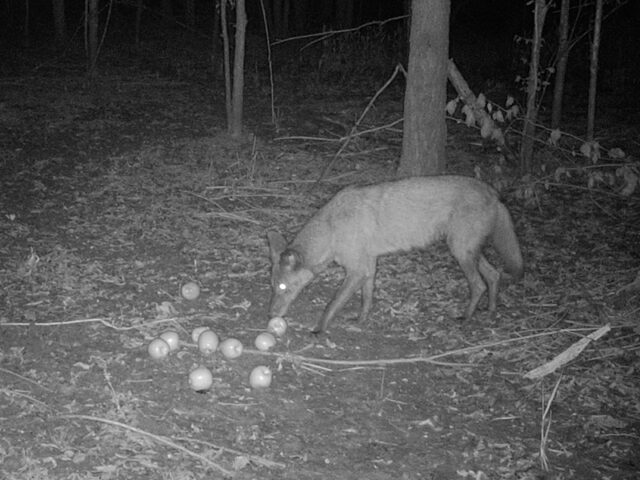

Unfortunately, making judgements about coloration based on black-and-white infrared photographs can be tricky. All that can really be gauged is whether the colors are darker or lighter than what might normally be expected. A daytime picture in full color would be required to make a definitive judgement about this particular canid. But, after such a great start, I was sure I would have the picture evidence I needed in short order.
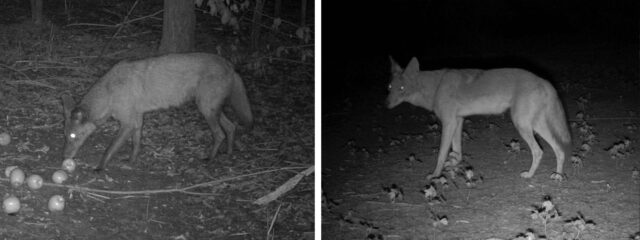
Notice the dark legs, snout, and ears as compared to they typical Coyote.
Click to Enlarge
Somewhat disappointingly, that is not the way things worked out. After that first night, Coyote pictures came in at an agonizingly slow rate. Most weeks I would only get one or two pictures of Coyotes passing through. The vast majority of these pictures were of decidedly normal Coyotes. Some of the pictures were clear daytime images, but they were often motion-blurred. The balance were difficult-to-judge nighttime photographs.
Every so often I would get a picture that was a little different. Some of these photographs showed what appeared to be unusual coloration or odd physiology. And while certainly intriguing, none of these pictures were what I would call conclusive.
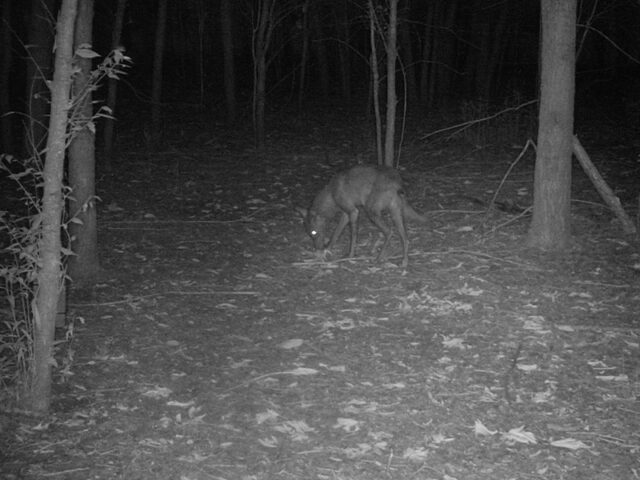
He may be the same individual photographed on the first night

both photographed under similar lighting conditions.
Click to Enlarge

The color difference between the two appears to be stark in these B&W images
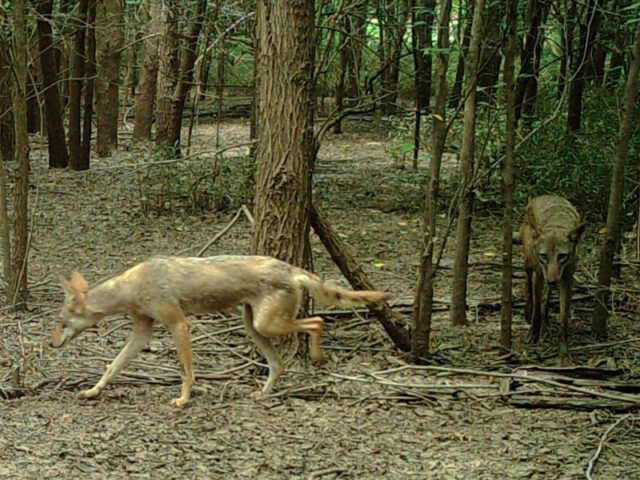
As more pictures came in over the course of the summer it became evident that there were at least a couple of Coyotes that seemed to possess slightly unusual color morphs. There was a rufous individual who appeared to be a good candidate for a hybrid. He had a dark face and legs, and the fur on his back was redder than that of a typically colored Coyote. He stopped in front of my camera several times as the season went on.

An unusually reddish Coyote with dark legs and ears
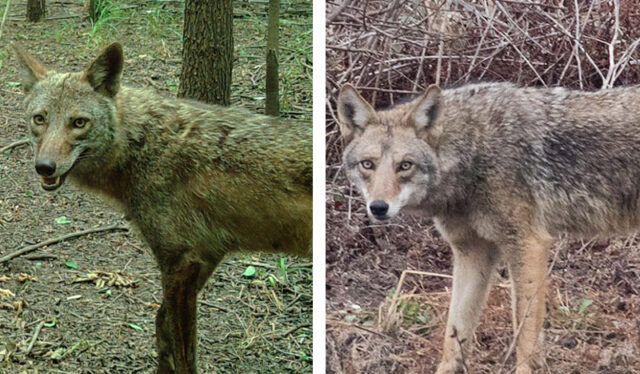

This time with substantial motion blur
Later, a darkly colored (almost entirely black) Coyote began appearing in my photographs. This animal also looked to be a good possible hybrid, but he also seemed to have mange—or some other skin condition. It is not clear how much that condition contributes to his darker appearance. Most all of the other Coyotes photographed during this project appeared healthy and mange-free. So this black Coyote is definitely an outlier, and that muddies the water a bit.
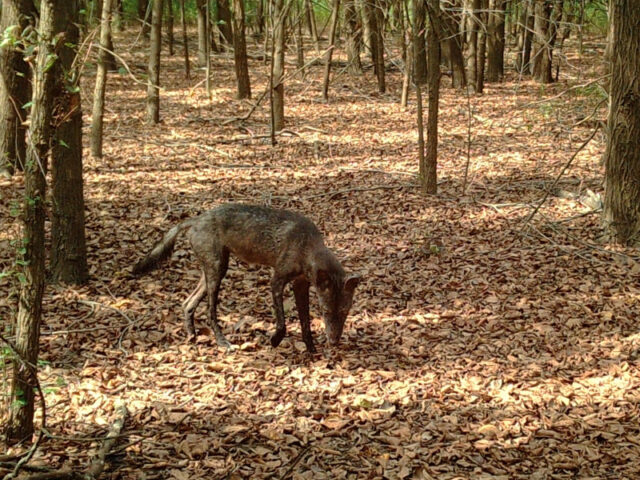
the first of many appearances in front of the camera
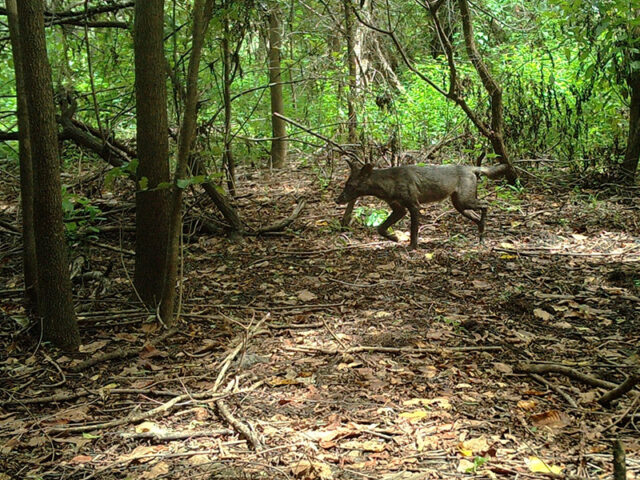

Over the course of this project I also recorded pictures of the occasional dog, but never one in the company of Coyotes. Shockingly, I also recorded a House Cat wandering around deep in the river bottoms. A tough and resourceful old feline, no doubt.
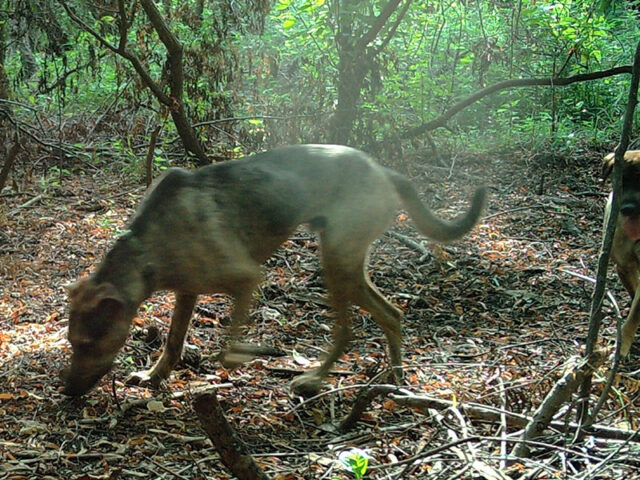

Conclusions
Even under the best conditions the odds are against Coyote pup survival. Somewhere north of 50% of Coyote pups do not survive their first forays from the den. It is estimated that 50 to 70% of Coyotes do not survive their first year of life.
The odds are certainly much worse for CoyDog pups. Female Coyotes depend on their mates for assistance raising their litters. Male Coyotes bring food back to the den and offer protection for the female and her pups. Male Dogs are not likely to be that invested. A female Coyote that breeds with a male Dog is going to be on her own when it comes to raising her pups. It appears that few, if any CoyDog pups can be expected to survive into adulthood.
It’s highly unlikely that there are CoyDogs running around in the bottomlands of Dallas County. The odds are decidedly against the possibility. Pictures alone may never be enough to prove out the hypothesis. Nothing short of a full blown DNA test will ever likely confirm Coyote-Dog hybrids in the Great Trinity Forest. Nonetheless, the photos acquired during this project are certainly intriguing—if yet still inconclusive.


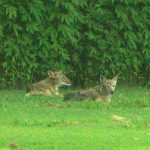

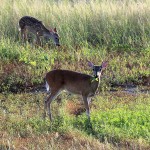
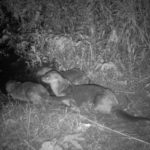
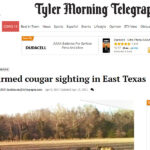
I stumbled across your blog doing some research on bobcats in my area (Bedford), and I’m so glad I did. What an informative site! Thanks and I look forward to reading your posts going forward.